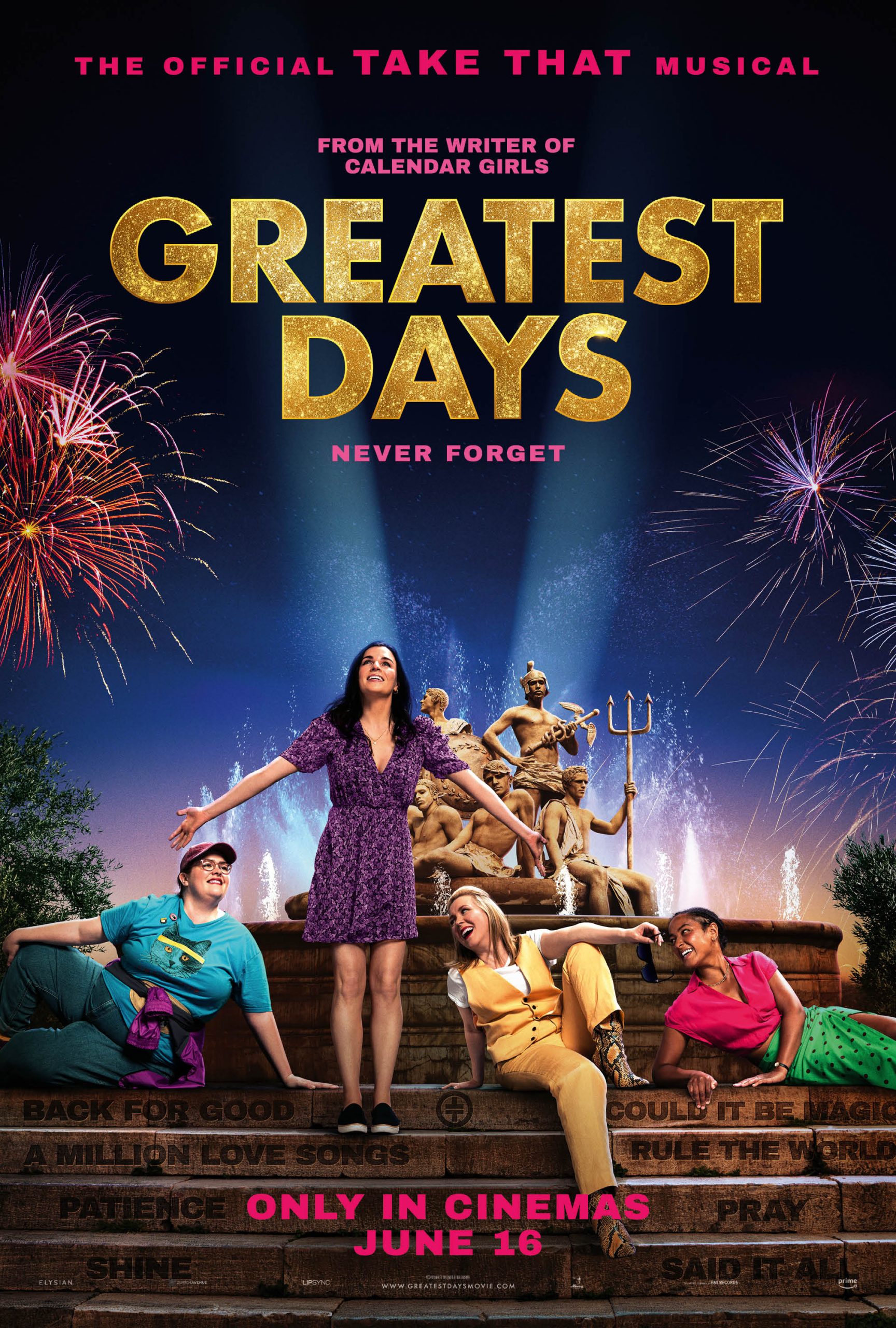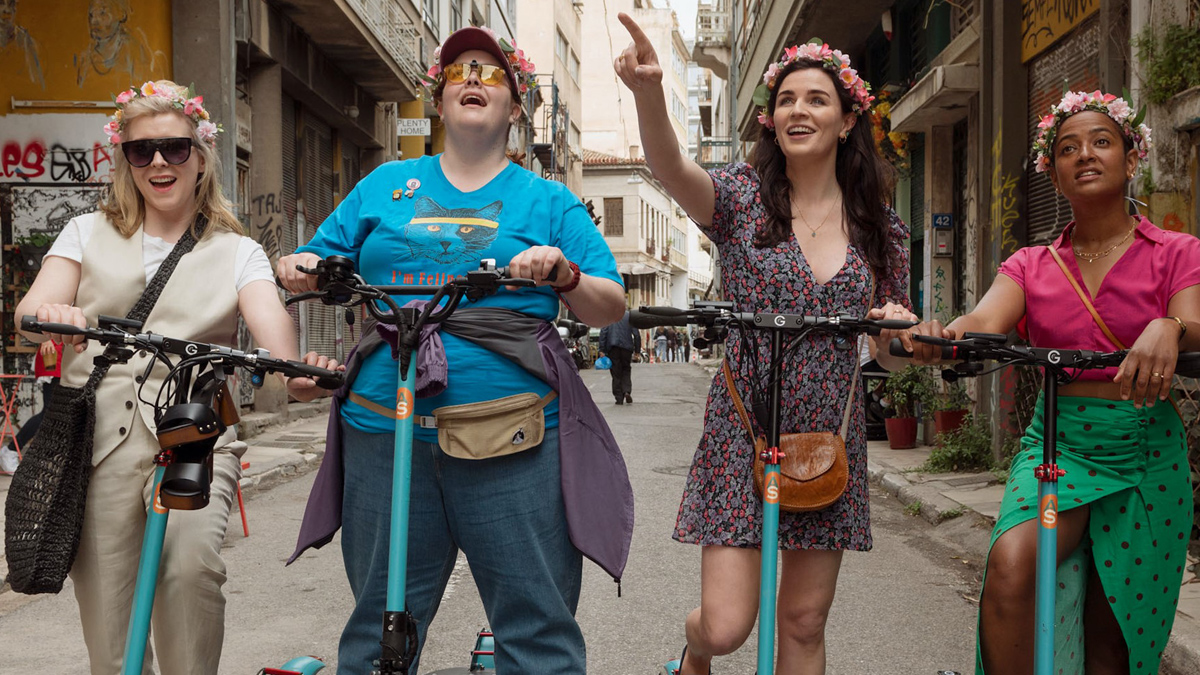Take That are one of the biggest bands in chart history and have garnered a legion of fans since they first appeared on the scene in the 1990s. In 2017, Tim Firth brought their music to the stage through the eyes of a group of friends in The Band. The show focuses on friends in the 1990s, and we see them 20 years later as they reunite for a gig. Now, How to Build a Girl director Coky Giedroyc has taken that stage play and adapted it for the screen in Greatest Days, which places Rachel, played by Irish actors Lara McDonnell and Aisling Bea, in the lead in a story that spans 25 years. We spoke with Coky Giedroyc to find out more.
Why did you want to tell this story?
The story existed as a musical called The Band. I came relatively late to it. Danny Perkins, the producer, contacted me and gave me the script. I absolutely loved it, but I’m an old bird, and my era was the 1980s. I didn’t know Take That as well as younger friends of mine. I took my daughters to see them play in Milton Keynes and Cardiff. I was blown away by the crowd, the fans and their enthusiasm and loyalty. My 16-year-old daughter didn’t know Take That either. She was a bit tired, but when they came on, she lit up. Being in the stadium with 100,000 mainly female fans, there were some great blokes but mainly female, who love that band, made me want to make the film for them and about them. There were mothers & daughters, friends on a hen night, grandparents, multi-generations of females. It was extraordinary. I watched the fans as much as I watched the band. Once I saw that, I wanted to work on the script. I worked with Tim [Firth] and we shifted the structure of it quite a lot, and made it into the film it is now.
Tim Firth wrote the stage musical. How did he react to the changes you wanted to make to his original idea?
Tim is really collaborative and knows a good idea. He would push back on things that didn’t work and then embrace things that pushed it forward and made it more cinematic. The biggest thing I brought to the table was centring the story on Rachel [played by Aisling Bea]. Each character is equal in the film, but I felt strongly that Rachel had to lead the film. She had to be the heartbeat, and she had to take us through the whole story and be rooted emotionally. When Aisling came, she did some brilliant things, and Tim agreed that shifting the focus was the right way for the film.
How did you know that Aisling was right for the lead role?
We had a different cast originally; at the beginning, we had Rosamund Pike and Ruth Wilson. We were heading into production in March 2020, but COVID came, and we were in and out of production for two years. It was stressful, but the cast stayed loyal to us for as long as possible. They all had other obligations and couldn’t wait any longer. The only person that stayed throughout was Jayde Adams. She was the OG. We had to regroup and rethink everything, and that’s when I jumped in with Aisling because I was a massive fan of This Way Up. Aisling unlocked a brilliant comedic side and has accessibility and warmth. It was my idea that her character is a nurse. Aisling embodied no-nonsense, down-to-earth, so a nurse made sense for her. There are some interesting shifts in the film, which Aisling helped unlock.
How did you approach casting the younger actors?
I saw hundreds of kids at open castings, through self-tapes, and put out calls to dance schools, musical theatre academies, and anywhere where young people were training. Some of them stick with you. I saw Carragon Guest and knew she would be the younger version of Jayde’s character, and Jayde worked with her to pick up her mannerisms. It is like juggling; you see someone and think, oh my god, they would be amazing, but do they fit? How can we work with them to be the younger version? I went to see Belfast, and I noticed Lara McDonnell; she was incredible. It was a no-brainer to cast her as the younger version of Aisling’s character, Rachel. They would have spa days together to get to know each other.
It is a lot of juggling because you also have the dancers who play the boys. Was the casting process different for them?
Yes. We had a whole separate casting system for the dancers. We had a casting director for actors and a casting director who did all the musical dance casting. I went to Magic Mike. I went to see ballet and a ton of musical theatre. We had these big auditions and had to narrow that down to just five actors.


You did a live tv version of The Sound of Music. Did it prepare you for Greatest Days?
Yeah, it was really good groundwork for me because it was about rehearsal time. You don’t get much rehearsal time in film, and in television, you get none. When I did the Sound of Music, I was given ten weeks of rehearsal, and I worked with people who taught me how to structure it and drill the dancers, and the importance of planning and workshopping routines. Working with dancers is a revelation; the discipline and the collaborative nature is mind-blowing. They are amazing. They lift your spirits every time they are on set.
The opening sequence dance routine is wonderfully imagined. Was that a collaboration between you and your choreographer?
Tim wrote this glorious sequence; from the beginning, he rightly said that we must set our stall out. We have to do something really wonderful and slightly off-theme up front in the film to let the audience know they are about to watch magic realism. These girls have this imagination it is part of their lives; now and then, these boys will appear. Tim said you have got to catapult the audience right into this world, and he was right.
You have worked a lot in period drama. Did the 1990s feel very different in practice?
They are different disciplines, but it’s all about the prep. I storyboard everything. I draw it all. I know how I’m going into scenes. It doesn’t make any difference what period it seems as long as I know what beat I need to hit within each scene, where I’m coming from and where I’m going. The period is wigs, costumes, and corsets; everything else is just the tools you need to tell your story. Whether it’s a horse-drawn carriage, a dance routine, or little magical realism, it is still about where I’ve got to go, what the character feels, and how I navigate it. I try not to get scared of the scale or the rigmarole of it. Walking onto the tarmac in Stansted Airport, them shutting down a part of the airport for us, and a plane flying while 50 dancers did a scene in Greatest Days felt pretty awesome. It was surreal. It was amazing. I loved it, it was a high career high.
How involved was Take That in the film?
They were very involved. Robbie wasn’t involved, but he is very supportive. Gary, Mark, and Howard got really involved, particularly in the music. Their sound engineer Ryan worked with our composers to structure the songs and give them a 90s shine. In terms of filming, they were so supportive; they would come on Zoom with me and tell me how brilliant they thought it was going. They visited the set. They are genuinely nice people and feel humbled by it all. They never wanted it for themselves, they were always adamant that it was about the fans. Obviously, they love that the music is out there again, but the main thing was telling the story and using the songs with real integrity and real heart; that is what they care about.
There is a scene at the end where the younger characters and their adult selves come together; it is so beautiful and emotive. What was it like bringing that together?
It was really amazing filming it. It is giving me goosebumps just thinking about it. It was incredibly simple, I didn’t do anything fancy with it. I didn’t want it to feel interfered with or have any CGI. The simplicity of it is what I’m really proud of. We did most of those little scenes over two nights. It’s not in the film, but when we were rehearsing, the glass blew out the side of a window on the street because it was incredibly windy and very atmospheric. It felt like something special was happening. The cast had all made real relationships with each other, the older actors, and the younger selves. We’d stayed in Athens together in the same hotel. We had a connection, and that scene was a quiet, lovely thing to do.
Words – Cara O’Doherty
GREATEST DAYS is at Irish cinemas from June 16th


